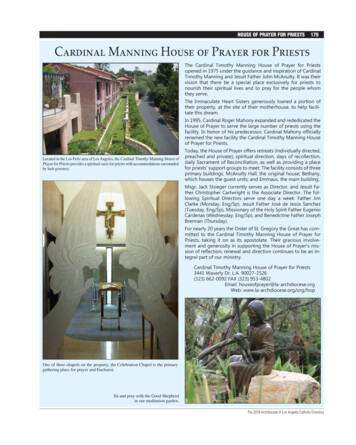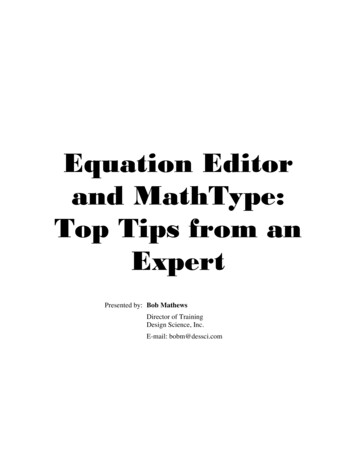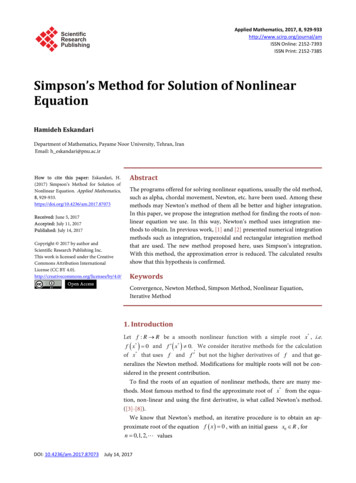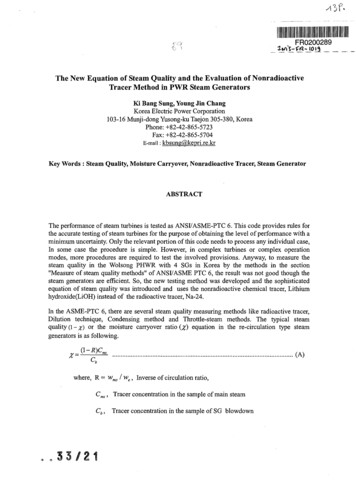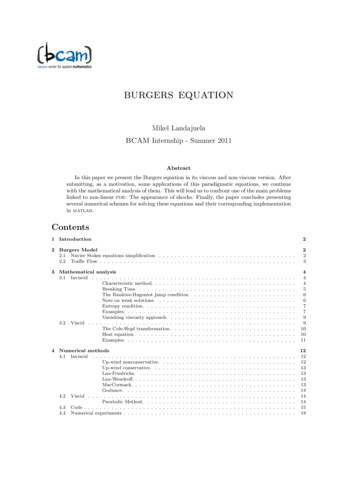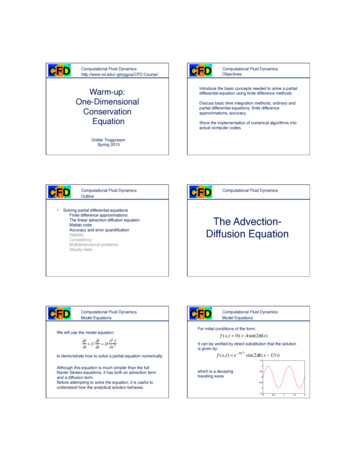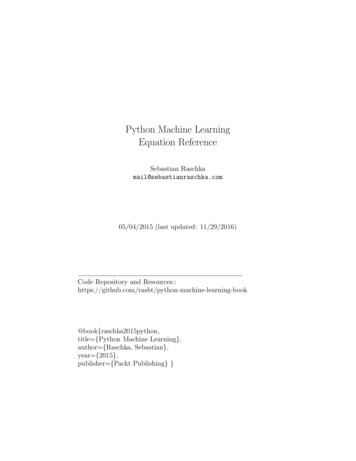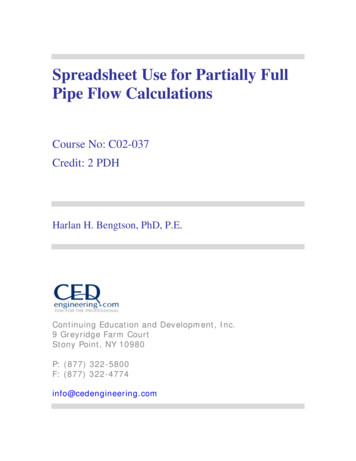
Transcription
Spreadsheet Use for Partially FullPipe Flow CalculationsCourse No: C02-037Credit: 2 PDHHarlan H. Bengtson, PhD, P.E.Continuing Education and Development, Inc.9 Greyridge Farm CourtStony Point, NY 10980P: (877) 322-5800F: (877) 322-4774info@cedengineering.com
Spreadsheet Use for Partially Full Pipe Flow CalculationsHarlan H. Bengtson, PhD, P.E.COURSE CONTENT1.IntroductionThe Manning equation can be used for uniform flow in a pipe, but the Manningroughness coefficient needs to be considered to be variable, dependent upon thedepth of flow. This course includes a review of the Manning equation, along withpresentation of equations for calculating the cross-sectional area, wetted perimeter,and hydraulic radius for flow of a specified depth in a pipe of known diameter.Equations are also given for calculating the Manning roughness coefficient, n, for agiven depth of flow in a pipe of known diameter. Numerous worked examplesillustrate the use of these equations together with the Manning equation forpartially full pipe flow. A spreadsheet for making partially full pipe flowcalculations is included with this course and its use is discussed and illustratedthrough worked examples.
2.Learning ObjectivesAt the conclusion of this course, the student will: Be able to calculate the cross-sectional area of flow, wetted perimeter, andhydraulic radius for less than half full flow at a given depth in a pipe ofgiven diameter. Be able to calculate the cross-sectional area of flow, wetted perimeter, andhydraulic radius for more than half full flow at a given depth in a pipe ofgiven diameter. Be able to use Figure 3 in the course material to determine the flow rate at agiven depth of flow in a pipe of known diameter if the full pipe flow rate isknown or can be calculated. Be able to use Figure 3 in the course document to determine the averagewater velocity at a given depth of flow in a pipe of known diameter if thefull pipe average velocity is known or can be calculated. Be able to calculate the Manning roughness coefficient for a given depth offlow in a pipe of known diameter, with a known Manning roughnesscoefficient for full pipe flow. Be able to use the Manning equation to calculate the flow rate and averagevelocity for flow at a specified depth in a pipe of specified diameter, withknown pipe slope and full pipe Manning roughness coefficient. Be able to calculate the normal depth for a specified flow rate of waterthrough a pipe of known diameter, slope, and full pipe Manning roughnesscoefficient. Be able to carry out the calculations in the above learning objectives usingeither U.S. units or S.I. units. Be able to use the spreadsheet included with this course to make partiallyfull pipe flow calculations.
3.Topics Covered in this CourseI.Manning Equation ReviewII.Hydraulic Radius - Less than Half Full FlowIII.Hydraulic Radius - More than Half Full FlowIV.Use of Variable n in the Manning EquationV.Equations for Variable Manning roughness coefficientVI.Flow Rate Calculation for Less than Half Full FlowVII. Flow Rate Calculation for More than Half Full FlowVIII. Normal Depth Calculation ReviewIX.Normal Depth for Less than Half Full FlowX.Normal Depth for More than Half Full FlowXI.SummaryXII. References4.Manning Equation ReviewThe most widely used equation for uniform open channel flow* calculations is theManning equation:Q (1.49/n)A(Rh2/3)S1/2(1)Where: Q is the volumetric flow rate passing through the channel reach in cfs. A is the cross-sectional area of flow normal to the flow direction in ft2.
S is the bottom slope of the channel** in ft/ft (dimensionless). n is a dimensionless empirical constant called the Manning Roughnesscoefficient. Rh is the hydraulic radius A/P. P is the wetted perimeter of the cross-sectional area of flow in ft.*You may recall that uniform open channel flow (which is required for use of theManning equation) occurs for a constant flow rate of water through a channel withconstant slope, size and shape, and roughness. Uniform and non-uniform flows areillustrated in the diagram below.Uniform partially full pipe flow occurs for a constant flow rate of water through apipe of constant diameter, surface roughness and slope. Under these conditions thewater will flow at a constant depth.**S is actually the slope of the hydraulic grade line. For uniform flow, the depthof flow is constant, so the slope of the hydraulic grade line is the same as the slopeof the liquid surface and the same as the channel bottom slope. The channelbottom slope is typically used for S in the Manning equation.It should also be noted that the Manning equation is a dimensional equation. Withthe 1.49 constant in Equation (1), the parameters in the equation must have theunits shown in the list below the equation.
For S.I. units, the constant in the Manning equation changes slightly to thefollowing:Q (1.00/n)A(Rh2/3)S1/2(2)Where: Q is the volumetric flow rate passing through the channel reach in m3s. A is the cross-sectional area of flow normal to the flow direction in m2. S is the bottom slope of the channel in m/m (dimensionless). n is a dimensionless empirical constant called the Manning Roughnesscoefficient. Rh is the hydraulic radius A/P. P is the wetted perimeter of the cross-sectional area of flow in m.Table 1. Typical Manning Roughness Coefficient Values
Values of the Manning roughness coefficient, n, for some common open channelmaterials are given in Table 1 above. The source for the n values in the table iswww.engineeringtoolbox.com.5.Hydraulic Radius – Less than Half Full FlowThe hydraulic radius is one of the parameters needed for Manning equationcalculations. Equations are available to calculate the hydraulic radius for knownpipe diameter and depth of flow. The equations are slightly different depending onwhether the pipe is flowing less than half or more than half full. The calculationsfor less than half full pipe flow will be covered in this section and the more thanhalf full calculation will be covered in the next section.The equations needed to calculate the cross sectional area of flow, A, the wettedperimeter, P, and the hydraulic radius, Rh, are shown below, along with a diagramshowing the parameters for a pipe flowing less than half full. Note that theparameters r and h are used in the equations for A and P. For this case of less thanhalf full flow, h is simply equal to the depth of flow y, while r is the radius of thepipe, which is D/2.
Example #1: Calculate the hydraulic radius (ft) for water flowing 6 inches deep ina 48-inch diameter storm sewer.Solution: r D/2 24 in 2 ft; h y 6 in 0.5 ft;θ 2 arccos [ (2 – 0.5)/2) ] 1.45 radiansA [ 22 (1.45 – sin (1.45)) ] / 2 0.91 ft2P (2)(1.45) 2.9 ftRh 0.91/2.9 0.31 ft
The screenshot above shows part of the “Q less than half full” worksheet in thespreadsheet that was included with this course. It shows the solution to Example#1. All that is necessary is the entry of the pipe diameter and the depth of flow.The spreadsheet will then calculate the area of flow, wetted perimeter, andhydraulic radius.Example #2: Calculate the hydraulic radius (m) for water flowing 20 mm deep ina pipe of 100 mm diameter.Solution: r D/2 50 mm 0.050 m; h y 20 mm 0.020 m;θ 2 arccos [ (0.050 – 0.020)/0.050) ] 1.85 radiansA [ 0.052 (1.85 – sin (1.85)) ] / 2 0.00111 m2P (0.05)(1.85) 0.0925 mRh 0.00111/0.0925 0.0120 m6.Hydraulic Radius – More than Half Full FlowThe equations for calculating the cross-sectional area of flow, A, the wettedperimeter, P, and the hydraulic radius, Rh, are shown below alongside a diagramshowing the parameters in the equations. For more than half full pipe flow, theparameter h is 2r – y, instead of simply being equal to y as for less than half fullpipe flow.Calculation of the area of flow and the wetted perimeter are slightly different thanthose calculations for the less than half full case. The area of flow is calculated asthe total cross-sectional area of the pipe minus the cross-sectional area of theempty space above the water. Similarly the wetted perimeter is calculated as thetotal perimeter minus the dry perimeter at the top of the pipe. These equations areshown below along with a diagram for “more than half full” pipe flow.
Example #3: Calculate the hydraulic radius for water flowing 3.4 ft deep in a 48inch diameter storm sewer.Solution: r 48/2 24 inches 2 ft; h 2*2 – 3.4 0.6 ftθ 2 arccos [ (2 – 0.6)/2) ] 1.59 radiansA π (22) - [ 22 (1.59 – sin (1.59)) ] / 2 11.38 ft2P 2 π (2) - (2)(1.59) 9.4 f5Rh 11.38/9.4 1.21 ftThis example can also be solved with the course spreadsheet as illustrated in thescreenshot below, which is from the “Q more than half full” tab in the coursespreadsheet. As you can see, the values for A, P, and Rh are the same as in thecalculations above.
7.Use of Variable n in the Manning EquationThe cross-sectional area, A; wetted perimeter, P; and hydraulic radius, Rh; can becalculated using the geometric/trigonometric equations presented in the previoustwo sections. It thus seems logical that the A and Rh values calculated in thismanner could be used in the Manning equation (along with the pipe slope and theManning roughness coefficient value for full pipe flow) to calculate flow rate for agiven depth of flow or normal depth for a given flow rate in partially full pipeflow.
Unfortunately, as early as the mid-twentieth century, it had been observed thatmeasured flow rates in partially full pipe flow do not agree with values calculatedas just described above. T. R. Camp developed a method for improving theagreement between measured values of partially full pipe flow rate and valuescalculated with the Manning equation. He did this by using a variation in Manningroughness coefficient with depth of flow in the pipe as a fraction of the pipediameter. That is, he used a variation in n/nfull as a function of y/D. His procedureis described in his 1946 article, “Design of Sewers to Facilitate Flow,” which isReference #3 at the end of this course. T. R. Camp’s work led to the graph below,which shows the variation of Q/Qfull, V/Vfull, and n/nfull as functions of the ratio ofdepth of flow to pipe diameter (y/D).The graph developed by Camp and shown in the diagram below appears in severalpublications of the American Society of Civil Engineers, the Water PollutionControl Federation, and the Water Environment Federation from 1969 through1992, as well as in many environmental engineering textbooks. The graph belowwas prepared from values read off a similar graph in Steel and McGhee’s textbook(Reference #5 at the end of this course).Prior to the common use of spreadsheets, which make calculations with thetrigonometric/geometric equations for A, P, and Rh, relatively easy, use of thegraph below was a widely used method of handling partially full pipe flowcalculations. Vfull and Qfull can be calculated for full pipe flow conditions in agiven pipe with the Manning equation. Then V and Q can be found for any depthof flow, y, in that pipe by reading values off the graph.
Figure 3. Flow in Partially Full PipesAlthough the variation in Manning roughness coefficient, n, shown in the graphabove, doesn’t make sense intuitively, it does work well in calculating values offlow rate, velocity, or normal depth that agree with empirical measurements. Keepin mind that the Manning equation was developed for flow in open channels withrectangular, trapezoidal, and similar cross-sections. It works very well for thosechannel shapes with a constant value for the Manning roughness coefficient, n.For partially full pipe flow, however, using the variation in n with depth of flow asproposed by Camp is a preferred method.Example #4: The flow rate and average velocity in a particular 21-inch diameterstorm sewer when it is flowing full, have been calculated to be: Qfull 9.12 cfs andVfull 3.79 ft/sec. Estimate the average velocity and flow rate in this storm sewerwhen it is flowing:a) at a depth of 8.4 inches andb) at a depth of 14.7 inches.
Solution: a) The depth/diameter ratio is: y/D 8.4/21 0.4. From the “Flowin Partially Full Pipes” graph above, at y/D 0.4: V/Vfull 0.7 and Q/Qfull 0.25. The flow rate and average velocity at y 8.4 inches can now be calculatedas follows:V (V/Vfull)(Vfull) (0.7)(3.79) ft/sec 1.95 ft/secQ (Q/Qfull)(Qfull) (0.25)(9.12) cfs 2.28 cfsb) The depth/diameter ratio is: y/D 14.7/21 0.7. From the “Flow inPartially Full Pipes” graph above, at y/D 0.7: V/Vfull 0.95 and Q/Qfull 0.7. The flow rate and average velocity at y 14.7 inches can now be calculatedas follows:V (V/Vfull)(Vfull) (0.95)(3.79) ft/sec 2.65 ft/secQ (Q/Qfull)(Qfull) (0.7)(9.12) cfs 6.38 cfs8.Equations for Variable Manning Roughness CoefficientAlthough the “Flow in Partially Full Pipes” graph can be used to determineaverage velocity and flow rate for partially full pipe flow, as shown in Example #3,it would often be convenient to be able to make such calculations with an Excelspreadsheet. In order to do that, the following set of equations have beendeveloped for n/nfull as a function of y/D, over the range from 0 y/D 1:0 y/D 0.03:n/nfull 1 (y/D)/(0.3)(3)0.03 y/D 0.1:n/nfull 1.1 (y/D – 0.03)(12/7)(4)0.1 y/D 0.2:n/nfull 1.22 (y/D – 0.1)(0.6)(5)0.2 y/D 0.3:n/nfull 1.29(6)0.3 y/D 0.5:n/nfull 1.29 - (y/D – 0.3)(0.2)(7)0.5 y/D 1:n/nfull 1.25 - (y/D – 0.5)(0.5)(8)
Note that the first 5 equations are for y/D 0.5 or less than half full. The lastequation covers the entire range for more than half full pipe flow.Example #5: Water is flowing through a 12-inch diameter corrugated metal pipe ata depth of 4 inches. The Manning roughness coefficient for full pipe flow in thecorrugated metal pipe is: nfull 0.022. Calculate the Manning roughnesscoefficient for the 4-inch deep flow in this pipe.
A spreadsheet for making partially full pipe flow calculations is included with this course and its use is discussed and illustrated through worked examples. 2. Learning Objectives At the conclusion of this course, the student will: Be able to calculate the cross-sectional area of flow, wetted perimeter, and hydraulic radius for less than half full flow at a given depth in a pipe of given .

